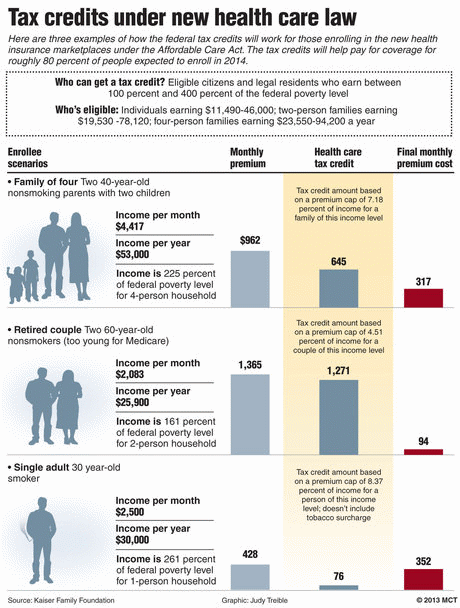
Approximately 85% of people expected to buy health coverage on the new Affordable Health Care Act insurance marketplaces next year will be low- and middle-income consumers. These individuals will receive federal subsidies, or “tax credits,” that will drastically cut their costs, according to the nonpartisan Congressional Budget Office. And they won’t have to wait to file their income taxes to get the money. When the marketplace open enrollment period under the new health care law begins on Oct. 1, the tax credits will be ready and waiting for eligible citizens and legal residents who earn between 100 percent and 400 percent of the federal poverty level.
In 2013, that includes individuals earning from $11,490 to $46,000, two-person families earning between $19,530 and $78,120, and four-person families earning between $23,550 and $94,200 a year. Tax credit eligibility will be based on the 2013 federal poverty guidelines until the 2014 guidelines are determined.
Legal immigrants with incomes below the poverty line are also eligible for tax credits if they don’t qualify for Medicaid because they haven’t lived in the United States for five years.
Even in the politically unlikely event that Affordable Health Care Act were to get defunded, the law’s tax credits, as well as many other provisions, would continue. That’s because not all of the funding for the health care law relies on money made available in the annual appropriations process, according to a recent Congressional Research Service memo.
The defunding question is under debate right now in the Senate as it considers a House bill that would temporarily fund the government for three months but block spending for the Affordable Health Care Act.
In fiscal 2014, the Congressional Budget Office estimates, tax credits will cost taxpayers $16 billion in direct spending and another $3 billion in indirect costs.
The size of the tax credit for a person receiving insurance coverage under the Affordable Health Care Act could range from a few hundred dollars to more than $10,000, based on family size, income and the cost of coverage in an individual’s area.
The amount will become known after submitting an online coverage application through the insurance marketplaces, which will be operated by either the states or the federal government. Once a person signs up for a marketplace health plan, the tax credit will be sent directly to the insurance company and applied to the plan member’s monthly premiums in 2014.
Keep in mind that most Americans – roughly 260 million with either government-sponsored coverage or access to job-based health insurance that meets the requirements of the Affordable Care Act’s individual mandate – won’t need the tax credit and are ineligible to receive it.
In fact, people with access to job-based coverage can only get a tax credit if their employer’s health plan doesn’t cover at least 60 percent of medical costs, or if costs are more than 9.5 percent of their annual income.
The tax credits are specifically designed to protect people from spending more than a certain percentage of their income on health insurance. Each state insurance marketplace will divide health plans into four color-coded categories, based on the portion of medical expenses they cover: All Bronze plans, for example, will cover 60 percent of medical costs, leaving the policy holder to cover the rest; all Silver plans, 70 percent; Gold plans, 80 percent; and Platinum plans, 90 percent.
A person’s tax credit amount will be based on the cost of the Silver plan in their area, which is known as the “benchmark plan.” Here’s how it is supposed to work:
Let’s say a 42-year-old man has a projected 2014 income of $28,725, which is 250 percent, or two-and-a-half times, the 2013 federal poverty level for an individual.
Under the Affordable Care Act, he would not have to pay more than 8.05 percent of his income – $2,312 – to enroll in the benchmark plan, which costs $5,800. This means his tax credit would equal $3,487 – the difference between the unsubsidized costs of the plan – $5,800 – minus the $2,312 cap on what he must pay for coverage.
People with lower incomes will be required to spend smaller shares of their income on coverage, which means they’ll get larger tax credits than those with higher incomes.
For example, people earning up to 133 percent of the federal poverty level would pay no more than 2 percent of their annual income for a benchmark plan. Those earning 150 percent to 200 percent of the poverty level would pay no more than 4 percent to 6.3 percent for a similar benchmark plan.
Keep in mind, the tax credits can only be used for coverage purchased through the marketplaces. And while the tax credit amount is based on the benchmark plan, it can be applied to any plan available in the marketplace, whether that plan is cheaper or more expensive than the benchmark plan.
On a cautionary note, if a family’s income or family size changes during the year from what was used to determine the amount of the tax credit, a plan member may have to repay any excess tax credit received.
For people earning less than twice the poverty level, the maximum amount of repayment is $300 for an individual and $600 for a family. Individuals and families earning between twice the poverty level, but less than three times, have a maximum repayment amount of $750 and $1,500, respectively.
Those making at least three but fewer than four times the poverty level have a maximum repayment of $1,250 for an individual and $2,500 for a family. People earning at least four times the poverty level would have to repay the entire amount of the overpayment.
To avoid being stuck with a large repayment bill, federal officials urge consumers to contact their insurer and the marketplace as soon as possible if their income or family size changes during their coverage year.

